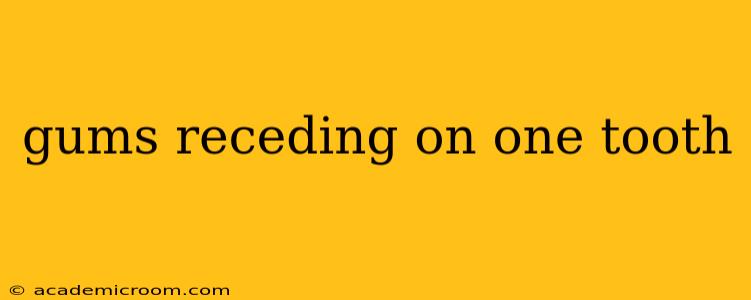Gum recession, where the gum tissue pulls back from the tooth, is a common dental problem. While it can affect multiple teeth, sometimes it only impacts a single tooth. This can be unsettling, but understanding the causes, available treatments, and preventative measures can help alleviate concerns and maintain oral health.
What Causes Gum Recession on One Tooth?
Several factors can contribute to gum recession on a single tooth, making diagnosis crucial for effective treatment. The most common causes include:
-
Aggressive Brushing: Brushing too hard or using a hard-bristled toothbrush can wear away gum tissue over time. This is particularly noticeable on one tooth if brushing techniques are inconsistent or overly forceful in a specific area.
-
Gum Disease (Periodontal Disease): This is a significant cause of gum recession. Inflammation and infection damage the tissues supporting the teeth, leading to gradual gum line retreat. While often affecting multiple teeth, it can manifest more severely on one tooth initially.
-
Genetics: Some individuals are genetically predisposed to gum recession, even with excellent oral hygiene. Thin gum tissue is a hereditary factor increasing vulnerability.
-
Trauma or Injury: A blow to the mouth or a dental injury can directly damage the gum tissue around a specific tooth, resulting in localized recession.
-
Teeth Grinding (Bruxism): Habitual clenching or grinding of teeth puts excessive pressure on the gums and supporting structures, potentially causing recession in one or more areas.
-
Misaligned Teeth (Malocclusion): Improperly aligned teeth can create areas of concentrated pressure, leading to gum recession in the affected zones. One tooth might bear the brunt of this pressure.
-
Piercings: Oral piercings, particularly those near the gum line, can contribute to gum recession due to irritation and inflammation.
-
Certain Medical Conditions: Some systemic illnesses can impact gum health, potentially contributing to recession.
What are the Signs of Gum Recession on One Tooth?
Recognizing the signs of gum recession early is crucial for effective treatment. Look for:
- Visible lengthening of the tooth: The tooth appears longer than adjacent teeth due to the receding gum line.
- Sensitivity to hot and cold temperatures: Exposed tooth roots are more sensitive than covered ones.
- Bleeding gums: This can be a sign of underlying gum disease.
- Redness or swelling of the gums: Indicates inflammation.
- Loose teeth: Severe gum recession can weaken the support structures holding teeth in place.
How is Gum Recession on One Tooth Treated?
Treatment options depend on the severity of the recession and the underlying cause. Your dentist will perform a thorough examination to determine the best course of action. Possible treatments include:
-
Scaling and Root Planing: This procedure removes plaque and tartar from beneath the gum line to address gum disease.
-
Gum Grafting: This surgical procedure involves taking tissue from another area of the mouth (often the palate) and attaching it to the area with gum recession to cover the exposed tooth roots. Different types of gum grafts are available, each suited to specific situations.
-
Pinhole Surgical Technique: A minimally invasive procedure that uses specialized instruments to reposition gum tissue without sutures.
-
Enamel Matrix Derivative (EMD) Gel: This gel stimulates the regeneration of gum tissue.
Can I Prevent Gum Recession on One Tooth?
Preventing gum recession involves proactive oral hygiene practices and regular dental checkups.
-
Gentle Brushing: Use a soft-bristled toothbrush and brush gently with short, back-and-forth strokes.
-
Proper Flossing: Remove plaque and food particles from between teeth daily.
-
Mouthwash: Therapeutic mouthwashes can help reduce plaque and bacteria.
-
Regular Dental Checkups: Professional cleanings and examinations can detect and treat gum disease in its early stages.
-
Stress Management: Stress can exacerbate gum disease, so finding healthy ways to manage it is beneficial.
-
Quit Smoking: Smoking significantly increases the risk of gum disease and makes treatment less effective.
Does Gum Recession on One Tooth Get Worse?
Yes, untreated gum recession can worsen over time. The exposed tooth roots become more vulnerable to decay and sensitivity. Furthermore, the loss of supporting gum tissue can lead to tooth mobility and even tooth loss. Early intervention is essential to prevent further progression.
Is Gum Recession on One Tooth Reversible?
While some minor gum recession might stabilize with improved oral hygiene, more severe recession often requires professional treatment for repair or restoration. Complete reversal is rarely possible, but treatments can halt progression and improve the appearance and health of your gums.
This information is for educational purposes only and does not constitute medical advice. Always consult with a qualified dentist for diagnosis and treatment of gum recession or any other dental concerns.
